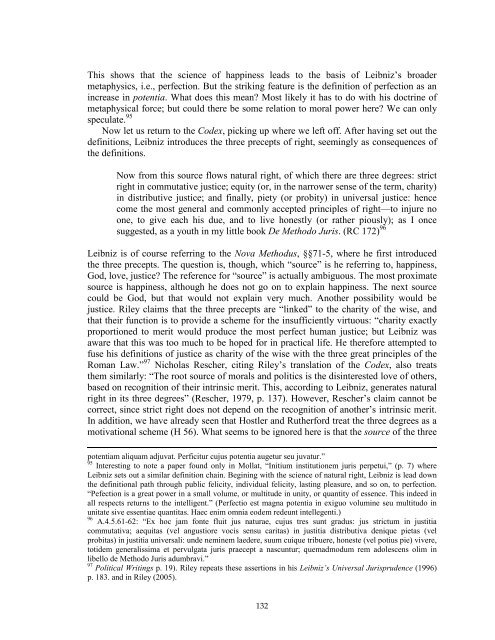Stony Brook University
Stony Brook University
Stony Brook University
Create successful ePaper yourself
Turn your PDF publications into a flip-book with our unique Google optimized e-Paper software.
This shows that the science of happiness leads to the basis of Leibniz’s broader<br />
metaphysics, i.e., perfection. But the striking feature is the definition of perfection as an<br />
increase in potentia. What does this mean? Most likely it has to do with his doctrine of<br />
metaphysical force; but could there be some relation to moral power here? We can only<br />
speculate. 95<br />
Now let us return to the Codex, picking up where we left off. After having set out the<br />
definitions, Leibniz introduces the three precepts of right, seemingly as consequences of<br />
the definitions.<br />
Now from this source flows natural right, of which there are three degrees: strict<br />
right in commutative justice; equity (or, in the narrower sense of the term, charity)<br />
in distributive justice; and finally, piety (or probity) in universal justice: hence<br />
come the most general and commonly accepted principles of right—to injure no<br />
one, to give each his due, and to live honestly (or rather piously); as I once<br />
suggested, as a youth in my little book De Methodo Juris. (RC 172) 96<br />
Leibniz is of course referring to the Nova Methodus, §§71-5, where he first introduced<br />
the three precepts. The question is, though, which “source” is he referring to, happiness,<br />
God, love, justice? The reference for “source” is actually ambiguous. The most proximate<br />
source is happiness, although he does not go on to explain happiness. The next source<br />
could be God, but that would not explain very much. Another possibility would be<br />
justice. Riley claims that the three precepts are “linked” to the charity of the wise, and<br />
that their function is to provide a scheme for the insufficiently virtuous: “charity exactly<br />
proportioned to merit would produce the most perfect human justice; but Leibniz was<br />
aware that this was too much to be hoped for in practical life. He therefore attempted to<br />
fuse his definitions of justice as charity of the wise with the three great principles of the<br />
Roman Law.” 97 Nicholas Rescher, citing Riley’s translation of the Codex, also treats<br />
them similarly: “The root source of morals and politics is the disinterested love of others,<br />
based on recognition of their intrinsic merit. This, according to Leibniz, generates natural<br />
right in its three degrees” (Rescher, 1979, p. 137). However, Rescher’s claim cannot be<br />
correct, since strict right does not depend on the recognition of another’s intrinsic merit.<br />
In addition, we have already seen that Hostler and Rutherford treat the three degrees as a<br />
motivational scheme (H 56). What seems to be ignored here is that the source of the three<br />
potentiam aliquam adjuvat. Perficitur cujus potentia augetur seu juvatur.”<br />
95 Interesting to note a paper found only in Mollat, “Initium institutionem juris perpetui,” (p. 7) where<br />
Leibniz sets out a similar definition chain. Begining with the science of natural right, Leibniz is lead down<br />
the definitional path through public felicity, individual felicity, lasting pleasure, and so on, to perfection.<br />
“Pefection is a great power in a small volume, or multitude in unity, or quantity of essence. This indeed in<br />
all respects returns to the intelligent.” (Perfectio est magna potentia in exiguo volumine seu multitudo in<br />
unitate sive essentiae quantitas. Haec enim omnia eodem redeunt intellegenti.)<br />
96 A.4.5.61-62: “Ex hoc jam fonte fluit jus naturae, cujus tres sunt gradus: jus strictum in justitia<br />
commutativa; aequitas (vel angustiore vocis sensu caritas) in justitia distributiva denique pietas (vel<br />
probitas) in justitia universali: unde neminem laedere, suum cuique tribuere, honeste (vel potius pie) vivere,<br />
totidem generalissima et pervulgata juris praecept a nascuntur; quemadmodum rem adolescens olim in<br />
libello de Methodo Juris adumbravi.”<br />
97 Political Writings p. 19). Riley repeats these assertions in his Leibniz’s Universal Jurisprudence (1996)<br />
p. 183. and in Riley (2005).<br />
132
















